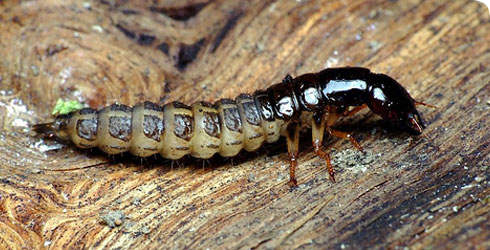Biology
Defense mechanisms
When Ocypus olens is threatened it produces an unpleasant smelling chemical defence from a pair of exocrine glands found at the terminal segment (8th tergite) of the abdomen.
It can also excrete fecal fluid from its anus as well as foul smelling fluid from its mouth.
Reproduction and life cycle
Ocypus olens reproduction takes place in the autumn.
1. An egg is laid
14-21 days after mating, the female lays a single egg in a damp, dark place such as
- leaf litter
- under stones
This provides the emerging larvae with a habitat.
2. Larva emerges
The larva emerges after 30 days and will live mainly underground. It is predacious like the adult, and has a similar diet and defence behaviour.
The larva has 3 successive growth stages, called instars. The final larval stage at approximately 150 days reaches 20-26mm in length.
3. Larva pupates
At this stage, pupation begins, taking up to 35 days.
4. Adult emerges and the cycle begins again
The fully grown adult then emerges from the pupae, remaining inactive for up to 2 hours whilst the wings dry out. These can then be folded under the protective second wing cases (elytra).
Adults can either:
- remain active throughout a second winter if conditions are mild
- hibernate underground, emerging again in March
